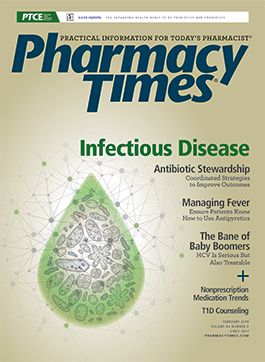Advancements Come With a Cost: Oral Chemotherapy Parity Laws
Pharmacy is a service profession in which we have the utmost responsibility to improve outcomes, lower cost, and improve the quality of life for patients with all types of health conditions.
Pharmacy is a service profession in which we have the utmost responsibility to improve outcomes, lower cost, and improve the quality of life for patients with all types of health conditions.1 With the advances in detection and treatment of cancer, we now have more of an opportunity to improve this patient population’s overall experience, and an important aspect of that involves the way in which therapy is administered.
Evolving Role of Oral Chemotherapy
To date, the FDA has approved more than 50 oral anticancer medications, and it is estimated that 25% to 35% of the therapies in the oncology pipeline will be available only in solid-dosage forms, either tablets or capsules.2 The FDA approved imatinib (Gleevec), a tyrosine kinase inhibitor, as the first-line treatment for Philadelphia chromosome—positive chronic myelogenous leukemia (CML) in which there is no comparable intravenous (IV) formulation.3 With 10% of patients with cancer failing to pick up their prescription medication to commence therapy, because of cost, we see an issue arising.4
Expensive Pills or Invasive Chemo?
Oral treatments offer patients particular advantages over the traditional IV therapies, and results from literature reviews show a distinct patient preference for oral treatments over the IV alternative. The most frequently reported factors are the convenience and ability to receive treatment at home, the possibility of fewer adverse effects, and the lack of complications with the administration of solid-dosage forms, along with enhanced flexibility and timing, compared with the IV approach.5 Overall, this decision regarding the route of administration depends mainly on the preference of the patient and physician, along with the ability of the patient to properly adhere to the therapeutic regimen. Unfortunately, the provisions in the patient’s health insurance plan and the cost-sharing responsibility for the patient under the insurer’s policy also loom large in this decision.
Insurers usually cover IV chemotherapy on an outpatient basis as part of the patient’s medical benefits coverage, resulting in a minimal office visit co-pay ($20 to $50) and a limit on annual out-of-pocket costs. However, oral chemotherapy is treated by most insurers as a prescription drug benefit, often using a 'tiered' structure that increases the patient’s cost-sharing responsibility as the price of the medication increases. Therefore, most patients must pay a significant out-of-pocket amount with no annual limit.6 Oral ponatinib (Iclusig), another tyrosine kinase inhibitor for the treatment of CML, is priced at $138,000 per year. So, with an average or typical insurance plan imposing 25% coinsurance, the patient would incur a $2500 monthly out-of-pocket cost. However, the co-pay for each office visit during which the patient is administered the IV counterpart is just $50.7
Addressing the Issue
Oral chemo parity laws have been adopted by 43 states that require health plans to cover oral cancer medications at a rate 'no less favorable' than the standard intravenous chemotherapy. At the federal level, the Cancer Drug Parity Act of 2017 (HR 1409) further specifies that patient-administered cancer medication 'is not subject to any prior authorization, step therapy, dollar or durational limit, co-payment, deductible, or coinsurance that does not apply to such provider-administered anticancer medications.'8 This proposed legislation has the potential to trim thousands of dollars in out-of-pocket costs for patients with cancer and would help ensure that all dosage forms of cancer therapy are accessible and affordable.
Approaches to treating cancer are changing, and this approach through legislation advances the argument that physicians and patients, not insurance companies, should determine the most effective therapy to treat each individual patient. For more information on the importance of oral chemotherapy parity laws and to download state-specific fact sheets on all existing state laws, visit the State Patients Equal Access Coalition website at speac.myeloma.org.
Lindsey B. Kays is a PharmD candidate at the University of Kentucky College of Pharmacy in Lexington.
Joseph L. Fink III, BSPharm, JD, DSc (Hon), FAPhA, is a professor of pharmacy law and policy and the Kentucky Pharmacists Association Endowed Professor of Leadership at the University of Kentucky College of Pharmacy in Lexington.
References
- Top ten goals for the profession of pharmacy. Pharm Times. pharmacytimes.com/blogs/redheaded-pharmacist/1011/top-ten-goals-for-the-profession-of-pharmacy. Published October 25, 2011. Accessed November 28, 2017.
- State Patient Equal Access Coalition. Oral oncology parity laws. speac.myeloma.org/wp- content/uploads/2014/08/OralOncologyParityOnePageFactSheet_August2014.pdf. Accessed November 28, 2017.
- Leukemia—chronic myeloid–CML: options. Cancer.Net. cancer.net/cancer- types/leukemia-chronic- myeloid-cml/treatment- options. Accessed November 29, 2017.
- DiFalco, L. Are cancer treatments becoming prohibitively expensive? Relias Academy website. blog.reliasacademy.com/are-cancer-treatments-becoming-prohibitively-expensive. Published June 5, 2017. Accessed November 28, 2017.
- Eek D, Krohe M, Mazar I, et al. Patient-reported preferences for oral versus intravenous administration for the treatment of cancer: a review of the literature. Patient Prefer Adherence. 2016;10:1609-1621. doi: 10.2147/PPA.S106629.
- Oral chemotherapy access legislation: impact on oncology practices and their patients. Oncol Prac Manage. oncpracticemanagement.com/issue-archive/special- issues/innovations-in-oncology-management-part-2/oral-chemotherapy-access- legislation-impact-on-oncology-practices-and-their-patients. Accessed November 28, 2017.
- Johnson CY. This drug is defying a rare form of leukemia — and it keeps getting pricier. Washington Post. washingtonpost.com/business/this-drug-is-defying-a-rare-form-of-leukemia-and-it-keeps-getting- pricier/2016/03/09/4fff8102-c571-11e5-a4aa-f25866ba0dc6_story.html?utm_term=.7de85d6a2da9. Published March 9, 2016. Accessed November 28, 2017. 8. Cancer Drug Coverage Parity Act of 2015. HR 2739, 114th Congress.

